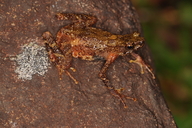|
Ansonia hanitschi Inger, 1960
| family: Bufonidae genus: Ansonia |
 © 2015 Sandra Goutte (1 of 7)
|
|
|
Country distribution from AmphibiaWeb's database: Malaysia
|
|
|
AMPHIBIAWEB
|
|||||||||||||||||||||||||||||
|
(Translations may not be accurate.) |
Country distribution from AmphibiaWeb's database: Malaysia
|
||||||||||||||||||||||||||||